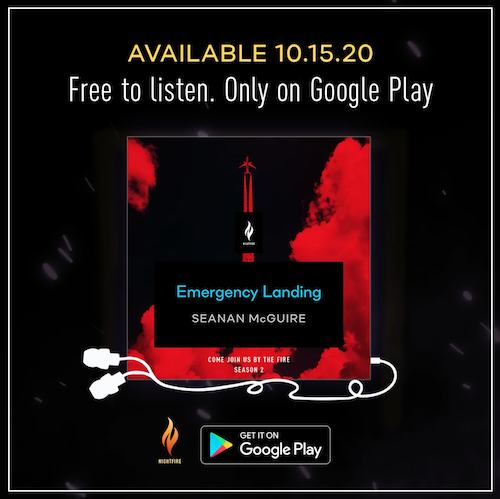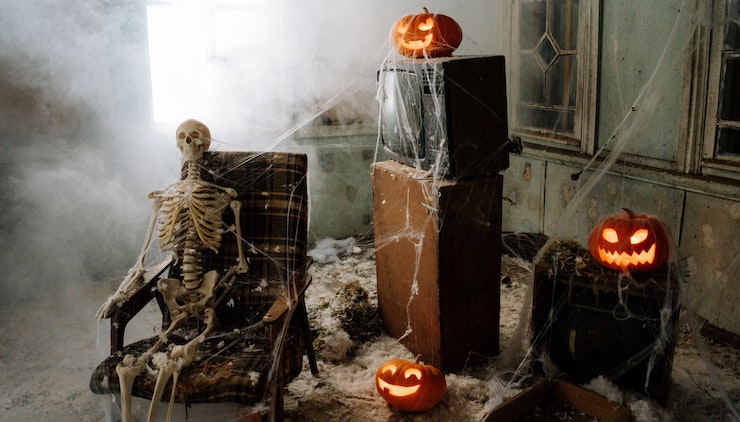Seanan McGuire on the Unsung Heyday of Horror TV
To celebrate the release of the second season of Come Join Us By The Fire, our audio horror anthology, we’ve asked authors with stories included in this year’s anthology to join us and write about horror. Below, Seanan McGuire, whose story “Emergency Landing” you can listen to here, writes about horror TV of the 1980s and 1990s, and comforting yourself with small terrors.
People like to talk a lot about the horror movies of the 1980s, and how it was in many ways a golden era for the genre—the perfect confluence of technological skill and script refinement, of practical effects and enough of a base to build on and understand what we were constructing. We had all the big beasts in place, all the major tropes, and we were creating the foundation of the next forty years of horror. There’s an innocence to 1980s horror, because new stories are being told, new foundations being constructed, new archetypes are being founded (and old archetypes are being dramatically reshaped, prepared for the new stresses of the modern world). So people love to talk about the movies that made them, the big set pieces in the history of their selves.
But people don’t talk nearly that much about the horror television of the 1980s.
The horror TV shows of the 1980s were an absolute bonanza for the horror-obsessed child. Movies were expensive. Movies required an adult who was willing to take you to the theater, and sit with you through whatever it was you had decided to see. Movies were often rated PG-13 or even R, making getting someone to buy you a ticket a matter of extreme and convoluted negotiations. But the TV shows were just there. If you could turn on the television, you could watch them. More importantly, they were mainstream enough to be found on broadcast television and basic cable—you didn’t need to have a rich kid family who could afford HBO and Showtime. They were open to anyone who had a television and the ability to turn the dial on.
I genuinely didn’t understand why anyone would ever go out on a Saturday night. I was too young to be dating, or to even believe that dating might be something people actually wanted to do with their time. Not when Freddy’s Nightmares and Friday the 13th: The Series were both on TV 20 starting at eight o’clock! Who would want to waste time going out with another person when they could be spending time with such good and glorious monsters?

My childhood was spent against a backdrop of some of the greatest horror movies ever made, but all my roots are in horror television, and I’m a little baffled by how little time we spend talking about it. The two shows that aired on the USA network at midnight were the real core of my passion for horror: Monsters and Tales from the Darkside. They were very much part of the tradition of The Outer Limits and The Twilight Zone, which came in turn out of radio shows like The Shadow and other genre terrors. They brought me a steady running stream of monsters in bite-sized pieces, small enough for my childhood mind to absorb, small enough to be defeated… mostly. One of the only things to ever cause me recurring nightmares was an episode of Monsters about a waterbed that ate people. Nom nom nom. My stepfather at the time came into the room to find me wrapped in my sleeping bag so that I was just a cocoon on the couch, nothing but huge blue eyes staring at the screen. He was so upset to find me scared that he turned off the television, forcing me to miss the end of the episode. This meant I didn’t learn how to defeat the monster. For the first time, there was a threat out there in the world, however ridiculous, that I didn’t know how to destroy.
That waterbed haunted me for years, until I was able to watch the episode in reruns, and discover the solution. I need to finish what I start, and that made horror television, on the whole, much better for me than movies. It was bite-sized, as small as I was, and I could swallow it safely.
There was a specific episode of Monsters, which aired in 1988, called “My Zombie Lover.” It was set in a world in which zombies happened annually, with the dead crawling out of their graves once a year. When this started happening was never explained that I can remember; it just did. Now, as an adult, I look at that premise with a lot of questions about how any traditions of burial or embalming could develop in a world where the well-preserved dead will inevitably rise again; why wouldn’t they just cremate everyone, or at least leave them out on the hillside for the vultures to devour? But a ten year old saw none of these questions. What I saw was a boy, risen from the dead but still very much in love with the girl he’d left behind, and a girl choosing the monsters over the men. What I saw looked very much like home.
“We will follow the monsters into the dark, and they will keep us company” is a theme that resonates through most of the media that made me. The Munsters, where Marilyn’s existence was enough to win out over the more casual ghoulishness of the Addams family, who might have a better theme song, but didn’t have a room for me in their beautiful home; Nightbreed, where a trip to Midian to be with the other monsters could result in a permanent homecoming; the Family stories of Ray Bradbury, which offered me another kind of homecoming; the unsung and underappreciated The Midnight Hour, a made-for-TV movie that again blurred the lines between the worlds of the living and the dead.
As a child, what I wanted more than anything was to leave the too-human monsters of my daily life behind and go to where the monsters wore their teeth and claws so much more honestly, on the outside. They might devour me, but they wouldn’t destroy me, and I loved them for that. And I found them most purely, most frequently, most fiercely in horror television, which had its day and then shambled, soft and sad, back into the grave.
Seanan McGuire is a native Californian, which has resulted in her being exceedingly laid-back about venomous wildlife, and terrified of weather. When not writing urban fantasy (as herself) and science fiction thrillers (as Mira Grant), she likes to watch way too many horror movies, wander around in swamps, record albums of original music, and harass her cats.
Seanan is the author of the October Daye and InCryptid series of urban fantasies, the Newsflesh trilogy, the Parasitology duology, the Wayward Children series, Middlegame, Into the Drowning Deep, and many more.
Listen to Seanan’s story “Emergency Landing” on Google Play here, and listen the the entirety of the second season of Come Join Us By The Fire here.



